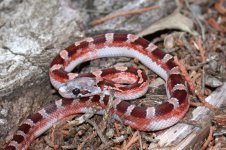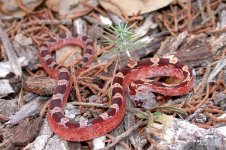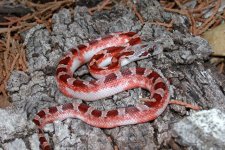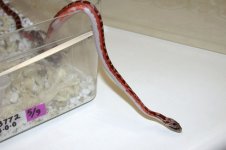SODERBERGD
New member
I guess this is the best place to post about this new line of bloodred corns. Perhaps the photo gallery would be better.
How these came to be is one of those looooonnnngggg stories, but for now the main player in the history of this snake is WALTER SMITH. If not for his insight, these new bloods might not have happened. I understand that he got the male we used to make these from Brad McDonald. We have yet to discover the true origins of these gems, but breeding trials will surely lead us to the starting place. Later, you'll see how tracking down the original gene carriers is not so clear. Like many genes, we may never discover the first captive carrier.
I'll go into more details about the family tree of this line in later posts of this thread. Here is one picture of what Rob and Louise Stevens call pie bald or PIED bloodreds. BTW, Rob and Louise have some of the brothers and sisters of my breeders so they'll be breeding these soon if they don't already have some. Since the piebaldism is mostly restricted to the sides, I'm leaning towards calling them pied sided bloods. I always like to look ahead and in case we later see a completely piebald corn like the ball pythons, this will help distinguish between the two in case they're not allelic. Very few of the places where white is located is disjunct from the belly white. Some have a few patches or scales of white on the face and some have smatterings of white disjunct from the ventral lateral junction of white and red you see on most corns. Suffice it to say, the majority of the white on the ones I hatched are connected to the white on the bellies. A nice sideline is that this line carries what you'd call a red sided trait whether or not they have the white laterally.
I'll post some more pictures later today when I get more caught up around here. "Caught up". Yeah, right. The squirmy little buggers don't love the camera so it's not only difficult to get them to co-operate, but the white is in so many places, it's tough to get just the right angle to show their most attractive profile. A better camera would help. I hope my wife is reading this. ahhuuumm
Walter, I cannot thank you enough for calling me three years ago and asking for my participation in this project. I'll give everyone the whole story when I get more time to type.
How these came to be is one of those looooonnnngggg stories, but for now the main player in the history of this snake is WALTER SMITH. If not for his insight, these new bloods might not have happened. I understand that he got the male we used to make these from Brad McDonald. We have yet to discover the true origins of these gems, but breeding trials will surely lead us to the starting place. Later, you'll see how tracking down the original gene carriers is not so clear. Like many genes, we may never discover the first captive carrier.
I'll go into more details about the family tree of this line in later posts of this thread. Here is one picture of what Rob and Louise Stevens call pie bald or PIED bloodreds. BTW, Rob and Louise have some of the brothers and sisters of my breeders so they'll be breeding these soon if they don't already have some. Since the piebaldism is mostly restricted to the sides, I'm leaning towards calling them pied sided bloods. I always like to look ahead and in case we later see a completely piebald corn like the ball pythons, this will help distinguish between the two in case they're not allelic. Very few of the places where white is located is disjunct from the belly white. Some have a few patches or scales of white on the face and some have smatterings of white disjunct from the ventral lateral junction of white and red you see on most corns. Suffice it to say, the majority of the white on the ones I hatched are connected to the white on the bellies. A nice sideline is that this line carries what you'd call a red sided trait whether or not they have the white laterally.
I'll post some more pictures later today when I get more caught up around here. "Caught up". Yeah, right. The squirmy little buggers don't love the camera so it's not only difficult to get them to co-operate, but the white is in so many places, it's tough to get just the right angle to show their most attractive profile. A better camera would help. I hope my wife is reading this. ahhuuumm
Walter, I cannot thank you enough for calling me three years ago and asking for my participation in this project. I'll give everyone the whole story when I get more time to type.




